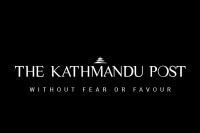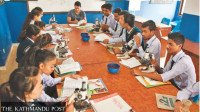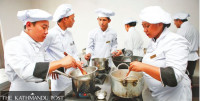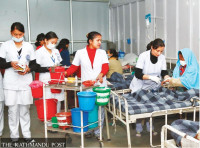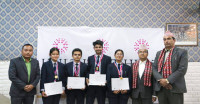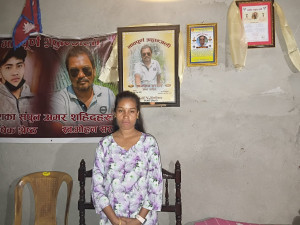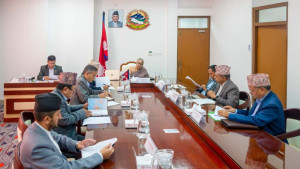Miscellaneous
The Person in a Woman
The Kathmandu Triennale is here and so is the excitement of having almost 50 artists from around the world gather in Kathmandu to exhibit their interpretations of the city.
The Kathmandu Triennale is here and so is the excitement of having almost 50 artists from around the world gather in Kathmandu to exhibit their interpretations of the city.
Ryan Elisabeth Reid, a postmodern dancer and choreographer from San Francisco, has taken on Kathmandu city as a studio from an intimately human perspective, and better yet she has plucked the theme apart to reveal the women and the girls. Aamaa has a very special place in the Kathmandu Triennale where majority of the works exhibited are within the realm of the visual arts. This is a multigenerational live performance of female dancers in Kathmandu. Together they lay out for you questions of age, time and the place of the feminine, through a postmodern approach to dance and performance.
Ryan draws a lot of her methods as a choreographer and dancer from her mentor, Anna Halprin. Halprin has been among the pioneers of postmodern dance in America. She is known for having created a space for dance and movement away from the rigidity of form. Her most influential technique, particularly for Ryan, has been that of scores. Through scores, dancers don’t need to adhere to a strict choreography. Instead, they improvise their movements based on the scores they get, which can be directions that are open ended, like “move in a way you have never moved before” or closed to a certain extent, like “pay attention to the person next to you.” The dancer takes this score and interprets it, in any way she feels. And thus begins a creative process of growth, learning and change within the realm of movement. Aamaa joins this endeavour by including dancers ranging from the eight-year-old Agriya, to the venerated dancer Honey Shrestha. As I observe the rehearsals, it is special to watch girls and women of different ages do the same gesture together in the same space. Every glance around the space becomes both sweeping and intricate in its display of the different generations.
Aamaa moves away from form as the main means of expression in movement. It pushes the contributing artists to express their inner truths, beyond their practised form. When I asked Ryan why that was the case, her determination to free dancers from long histories of form and structure sparked as she said, “Because, the form does not express who you are...it only expresses someone else’s version of it.” But the preparation for Aamaa has proved to be an interrogation and understanding of personalities, forms of dance, and the invisible yet potent energy of age giving rise to interesting formal and emotional challenges to everyone involved.
Much of the process in Aamaa is rooted in collective creativity. Decisions and choices are made by the dancers. There are innumerable discussions happening among them about different concepts, ranging from the female body to the identity of their respective decades. And these discussions add on to the dancers’ interpretation of the scores. It is a delight to see Ryan’s methods unfold in this process. She has often times come in with sheets of her own drawings and texts to guide both her and the participants in the process. But at the same time she takes spontaneous yet intuitive turns to change the direction of the sessions. There is a quietness and patience about her as she observes the dancers and that is suddenly subverted by her almost sharp clarity of what she wants out of them. This again is subverted by her honest acknowledgements of what she does not know. It is dynamic and humbling to watch her in action. She has handled the different cultural dynamics of Kathmandu with an openness and acceptance while still probing and pushing the dancers to reach a certain edge.
Different dancers have different ways of processing the rehearsals and that is morphing and changing with time. Surprisingly, it was often the dancer who expressed her confusion over the process that gave the most powerful performance.

For some dancers the affinity to their dance training became both their mask and their self expression. Their years of experience were like a skeleton supporting them in territories they had never ventured into. At those moments, I often wondered what would happen if their training suddenly left them and all they had were themselves and their bodies. How would their expression change then?
Some put up barriers to protect themselves while some let in everything to bring out their inner selves.
Others breathe and dance with the questions posed to them till they realise something about the process resonates with them. And even if it doesn’t, we get to see their movements reflect their search.
You could notice certain changes in ways some dancers expressed themselves. What was an elegant frame of the hands in the past, now became clenched fists pushing breaths down from their gut to the ground. It is extremely rewarding and touching to be able to observe an openness the dancer has only just embraced. The same person that was evidently shy and cynical of the process is now generous with what she is willing to offer, at the risk of being vulnerable.
The music is as malleable as the performers’ explorations in movement. They improvise with their sounds based on their interpretation of the dancers’ movements. Eventually there is a buzzing interaction of feedbacks between the dancers and the musicians. The whole group functions like an organism growing and evolving in real time. This decision comes with Aamaa’s need for space and flexibility to serve each performer’s expression, movement and growth and provides a beautiful ground for change between the dancers and the musicians.
As I talked to the dancers, I found that gender had an interesting playground here. Subima Shrestha, the founder of Nritya Aagan, shed light on her approach to Aamaa as being beyond gender. Whatever comes out of her is never a conscious direction of womanhood, or femininity. Instead it is whatever she is at that moment, as an artist. I asked Ryan what one did in a group like Aamaa, if the notion of the female identity does not flow as easily in oneself? She was adamant that each dancer was an individual, first and foremost. Different people have different ideas of what it means to be a female and she had no set agenda to highlight a certain kind of womanhood, a certain kind of feminine energy.
But I still wanted to know what being a female was for the different dancers. This performance uses different rituals to let these questions unfurl. A simple ritual like washing one’s hair becomes gestures. They begin to tell us a lot about our conditioning, yearning, my desperations and determinations. For most trained dancers, grace in their movements seemed to flow from them. But sometimes a trained grace and beauty gets in the way of the person. There was a silent frustration brewing inside of me because I felt I couldn’t see past their iterations of grace and beauty. When I asked her how she viewed womanhood in the context of Aamaa, it was jarring to hear Pooja say she was in it for the grace upfront because I had had glimpses of her desire to destroy the restrictions imposed by popular notions of grace and beauty. I realised my definition of grace was very flawed and prejudiced. For someone like Pooja, grace is not a stereotype of female identity, it is an aspiration. Such revelations and insights let the differences of womanhood within Aamaa flourish. There are dancers who look at themselves as artists first, and women second. There are those who look at themselves as a sister and a daughter first, and a woman second. Then there are those who take pride in motherhood, whether you have birthed a child or not.
Many things are unsaid in this performance, but are there to be witnessed. And witnessing this process is as important as being a part of it, as Pooja rightly pointed out. Watching and growing with the process in Aamaa has given me much space for change, reflection and awe. My cynicism towards issues of feminine identity and its place in an individual’s growth was reshaped by new understandings of what it can mean to use art to explore the feminine. While many forces have led to stereotyping what the feminine has been, there are simultaneously powerful oppositional forces that are reinstating and redefining what feminine energy can be. I strongly believe that Aamaa has the potential to fall in the latter category.
An interesting theoretical challenge that could fall for any art and culture theorist is the contextualisation of postmodern performance within the social and cultural realities of Kathmandu.
The term ‘Postmodern Dance’, often felt like a satellite, hovering around the dancers steeped in a culture of dance rooted to a style and a formal identity. What does one do if suddenly, someone tells you to let your back face the audience as you express yourself, when you have been taught to never do that as a dancer? What does one do, if a rehearsal is not driven by a dance choreography, but a question?
With this subversiveness comes a more tender and passionate approach to exploring human nature. With the radical shift away from a fixed choreography of imposed movements comes a radically sensitive way of delving deep into your questions of the self. And these explorations open up new windows to look out from, and connect with.
However, most of the women’s identities seem to be shaped by years of training in their dance form, like Kathak and the Chariya dance to the point that their expression in performance is founded on the moves they have ingrained in them. It would feel wrong to dismiss it as impersonal, because that is what has lent to their identities and self expression. It was interesting to notice this tug of war between form and the anti-form. There were moments when a grey area emerged between the dancer’s form and their being which was, in the end, neither. But those moments granted the performer’s self that we had never seen before.
There are intriguing possibilities of merging Kathak dance with postmodern techniques of performance and expression. As Ryan expressed, this might be the first instance of postmodern performance entering the sphere of classical forms of dance in Kathmandu and it has the opportunity of disseminating through women. Thankfully, there are influential and respected dancers to the likes of Honey Shrestha and Subima Shrestha who want to take this further.
The performance at Taragaon Museum will be the first time one can observe different generations of women performing, as they are exploring themselves, in the same space and time. And the wonderful thing is, everything around them, from the costume they are wearing, to the elements they have around them, to the music and sounds, are there to support them fully. The whole environment is at the service of their expression as individuals and as a group of women.
When I asked Mithila Sharma what she would like to tell those interested in coming to see the performance, she candidly expressed that they should come without any expectations of what a performance should be. I think that is the perfect way to approach Aamaa for it goes beyond a performance. It provides new opportunities for the audience as much as the contributing artists to experience and understand the individuals and their iterations of womanhood through a process that is very new to everyone involved. Aamaa is home to many contradictions. Some flourish while some crack and crumble, and slowly disappear. There is a chance that if we try and study these different dynamisms of contradictions, we might get to the pulse of something new and relevant to performance art in Kathmandu. That is perhaps the most exciting aspect of art—the possibility of change through a form of expression that is unprecedented.
Aamaa will be exhibited at Taragaon Museum, on March 28 at 2 pm, as a part of the Kathmandu Triennale




 24.12°C Kathmandu
24.12°C Kathmandu
